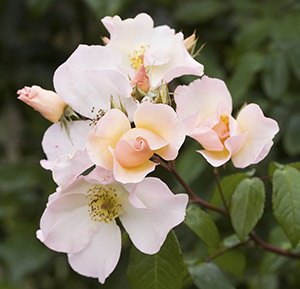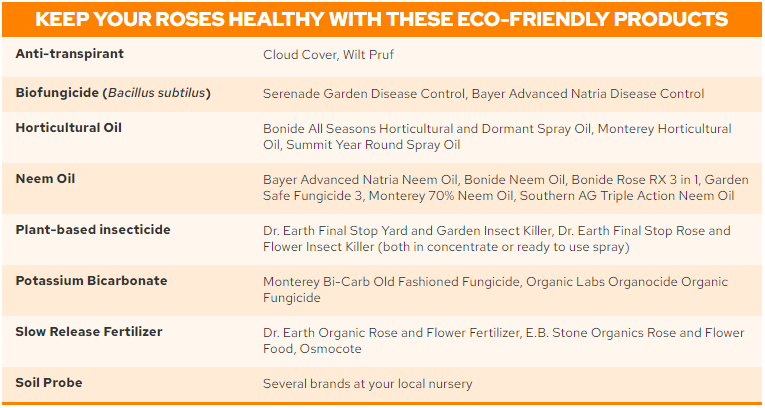
Learn about growing beautiful roses while using effective eco-friendly pest control and less toxic products with these tips from the City of Goleta’s Environmental Services Division. You can grow beautiful roses without using insecticides and fungicides which kill beneficial insects and pollute local creeks, rivers, bays, and the ocean. These tips will help you to protect your family’s health and the environment while you grow strong, healthy roses with glorious blooms.
Choosing the Right Rose
Do some homework before you choose! Before buying a rose, find out whether it’s a good match for your garden. Learn how much sun the rose needs, how well it will tolerate your garden’s climate, and whether it is prone to diseases such as rust and powdery mildew.
- No roses are completely disease-free, but many can be grown with minimal care. Choose rose varieties that are disease-resistant and suited to your garden’s climate. Some roses will not grow well in areas that are cool in summer and get a lot of fog. Rose varieties with fewer than 30 petals grow better in cool-summer areas.
- Visit a local rose garden during the growing season to see what different kinds of roses look like and to learn about how they grow and what they need to stay healthy.
- Ask local gardeners for suggestions. Contact local garden clubs, rose societies, nurseries, and Master Gardeners for lists of roses they recommend for your area.
- When you buy a new rose, be sure to start with a healthy plant.
Planting Roses
Before you buy, be sure you have a good spot in your garden for your new rose.
- Roses need at least six hours of direct sunlight per day for most of the growing season. Sunlight encourages blooms and discourages disease.
- Give roses room to grow. Good air circulation is very important for preventing disease.
- Consider planting roses in mixed beds (with other flowers and vegetables). Growing different types of plants in your garden attracts beneficial insects and helps roses stay pest and disease-free.
- Roses need good drainage. In the spot you’ve chosen for planting, dig a hole the size of a gallon jug and fill it with water. If the hole doesn’t drain in an hour or less, choose another spot or build a raised bed for your roses.
Caring for Your Roses
Water. It is important to give your roses the right amount of water. Waterlogged soil will kill roses, and drought conditions can stress plants, making them more susceptible to pests and diseases.
Fertilizer. Roses prefer slightly acidic soil (pH 6.2 to 6.8) that is not high in salt.
Mulch. Mulching with organic materials, like compost and shredded bark or leaves, helps to keep soil moist, control weeds, and improve soil structure. Mulching also keeps roots cool in summer heat. Mulch can prevent the spread of diseases like black spot by keeping fungus spores in the soil from splashing up onto the plant. Spread a two- to four-inch layer of mulch around each plant. Keep the mulch a few inches away from the trunk.
Pruning. Careful pruning helps keep roses healthy and prevents disease and pest problems. Pruning allows you to remove dead, spindly, or diseased parts of the plant, shape plants and promote flowering and new growth, and ensure good air circulation to discourage diseases. Use sharp tools so you won’t tear the bark or damage the cane.
Managing Common Rose Pests and Diseases
Many common pests and diseases that affect roses can be controlled without resorting to chemical pesticides. Inspect plants regularly to detect any diseases or pests before they become a problem. Become familiar with the pests and diseases that are common in your area. Before you treat plants for insect problems, look for beneficial insects (good bugs) such as ladybugs, lacewings, syrphid flies, and orange-and-black soldier beetles. If you see these natural enemies of rose pests in your garden, don’t use an insecticide, because you are likely to kill more beneficial insects than pests (see Less-toxic Chemical Controls).
Less-toxic Chemical Controls
If disease or pest problems can’t be managed by good garden housekeeping, you may want to use a less-toxic pesticide. Because these products prevent but do not cure disease, treatments must begin before symptoms are widespread. To avoid burning leaves and flowers with chemical spray, water plants the day before you treat them and test a few leaves and petals before spraying the whole plant. Be sure to coat both sides of the leaves.
- Horticultural oils help protect roses from fungal diseases. They create a thin coating that keeps spores from infecting the leaves. Treatment should begin when new leaves appear in spring and must be repeated whenever you see new growth.
- Biofungicides attack fungal diseases like powdery mildew and black spot.
- Neem oil can help prevent powdery mildew, black spot, and rust. Neem oil is toxic to bees, so it is safest to spray it in the evening.
- Plant-based insecticides with garlic extract both kill and repel insect pests such as aphids and rose slugs (sawfly larvae). Apply early in the morning or at dusk, to prevent leaf burn.
- Potassium bicarbonate, similar to common baking soda, can prevent powdery mildew. It must be applied weekly.
- Sulfur can be effective against black spot, powdery mildew, and rust. Do not use when temperatures are higher than 85F° to avoid burning leaves.

Find more information on Growing Beautiful Roses in our OWOW brochures in English and Spanish.
The City of Goleta along with the Cities of Buellton, Carpinteria, Solvang, Santa Barbara, Santa Maria, and the County of Santa Barbara have partnered with the OWOW organization to promote the use of less-toxic products in an effort to reduce pesticide pollution in our communities. By reducing pesticide use and the use of less-toxic products around the home, you can help reduce pesticides and other pollutants such as herbicides and fertilizers from being picked up while watering or when it rains and transported to the nearest storm drain inlet and into our waterways. The OWOW website is a great resource for finding less-toxic products to use around your home or garden.

